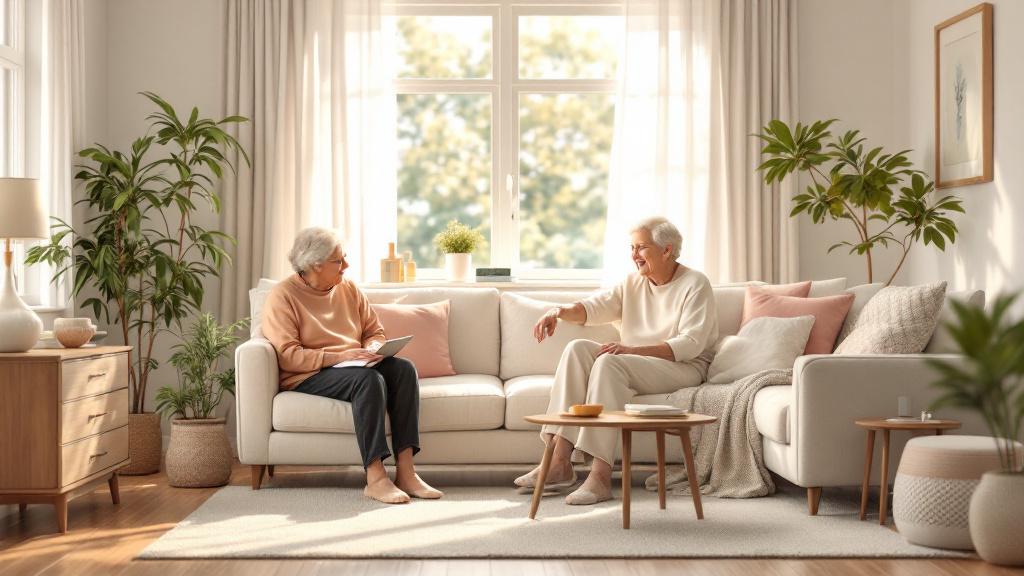Why In-Home Care is a Safer Alternative to Assisted Living Facilities
Exploring the Safety Benefits of In-Home Care Over Assisted Living

Understanding the Choice: In-Home Care vs Assisted Living
Choosing between in-home care and assisted living facilities is a significant decision for families with aging relatives. The decision often revolves around concerns about safety, emotional support, and financial considerations. This article delves into why in-home care presents a safer and often more beneficial alternative for seniors wishing to maintain independence while receiving needed assistance.
Key Differences Between In-Home Care and Assisted Living

What are the main differences between in-home care and assisted living?
The distinctions between in-home care and assisted living primarily lie in living arrangements and the type of care provided. In-home care allows seniors to remain in their own homes, where they can enjoy independence and familiarity. This setup promotes comfort and can significantly improve mental well-being by reducing feelings of loneliness and depression. Seniors receiving in-home care benefit from personalized assistance that caters to their specific needs, allowing for flexible schedules and tailored care plans.
Conversely, assisted living offers a community-type environment, where residents live in shared accommodations with access to round-the-clock support. Facilities provide meals, organized social activities, and medical care, which is beneficial for seniors requiring more intensive assistance. While this environment fosters socialization, it can sometimes feel overwhelming for those who prefer the tranquillity of their home.
Safety Considerations
Safety is another important factor that affects the choice between these two care options. In-home care can enhance safety through personalized assistance and the opportunity to address potential hazards in a familiar environment. Options such as home modifications, elder monitoring devices, and professional services ensure that seniors maintain safety and independence.
In assisted living settings, while 24/7 staff presence offers security, the potential for illness transmission, especially in the context of pandemic concerns, may pose additional risks for residents. Thus, families must weigh these considerations when deciding on the best care arrangement for their loved ones.
| Factor | In-Home Care | Assisted Living |
|---|---|---|
| Living Arrangements | Received in the senior's home | Shared community setting |
| Type of Care Provided | Personalized, flexible, part-time/full-time | 24/7 support for daily activities |
| Safety Considerations | Home modifications and monitoring services | Security through staff presence |
Examining the Benefits and Drawbacks of Home Care Services

What are the specific benefits and drawbacks of home care services?
Home care services offer numerous advantages for seniors wanting to maintain their independence while receiving assistance.
Benefits of Home Care:
- Familiar Environment: Seniors can live in their own homes, which helps them avoid the stress of relocating to an assisted living facility.
- Personalized Care: One-on-one attention ensures tailored support that addresses specific needs, enhancing comfort and emotional well-being.
- Cost-Effectiveness: In-home care typically costs between $5,000 and $30,000 per year, making it a more affordable option compared to the $30,000 to $100,000 for assisted living.
- Maintained Independence: Home care allows seniors to keep control over their routines, promoting dignity and self-worth.
- Pet Companionship: Unlike many assisted living facilities, seniors can retain their pets, which significantly contributes to their emotional health.
- Consistency of Care: Having the same caregiver fosters trust and stability, optimizing the quality of care received.
Drawbacks and Challenges:
- Limited Medical Support: Home care is non-medical support, which means it lacks the robust healthcare options available in assisted living facilities.
- Risk of Isolation: Seniors may experience loneliness due to less frequent interaction with peers, potentially impacting mental health.
- Service Reliability: Caregiver availability can vary, which might lead to inconsistencies in support.
In conclusion, when evaluating home care services, it's crucial to weigh health needs, personal preferences, and financial considerations to make an informed decision.
Safety and Emotional Support: In-Home Care Advantages

Is in-home care a safer option compared to assisted living facilities?
In-home care can be a safer option compared to assisted living facilities as it allows seniors to remain in a familiar environment. This setting promotes emotional stability and well-being, making it easier for older adults to feel secure. The one-on-one attention provided by caregivers enables personalized care plans that address specific health needs and facilitate early identification of health issues. This proactive approach enhances safety by reducing the risk of complications.
Moreover, in-home care supports flexible routines, allowing seniors to maintain their independence without the constraints often found in assisted living environments. Adjustments in daily life can be more gradual, which helps to avoid the stress of moving and adjusting to new communal living arrangements. Additionally, seniors can retain pet ownership, which is a crucial factor in emotional support, as pets contribute significantly to their mental wellness.
Which option provides better emotional and social support: in-home care or assisted living?
In terms of emotional and social support, in-home care generally provides a more favorable environment compared to assisted living. Caregivers foster companionship and familiarity, creating meaningful connections that help combat feelings of loneliness, which are common among seniors. This personalized approach enables the delivery of tailored support that directly addresses their emotional needs, ultimately enhancing overall health outcomes.
The continuity of care in a home setting strengthens relationships between caregivers and clients, enabling early detection of potential emotional issues and facilitating better communication. By prioritizing emotional health alongside physical support, in-home care results in a nurturing environment that can significantly improve the quality of life for seniors.
In-Home Dementia Care: A Closer Look
How does in-home care for dementia patients compare to assisted living?
In-home care for dementia patients presents an option that emphasizes comfort and familiarity, allowing individuals to stay in their own homes surrounded by cherished belongings and loved ones. This setting can promote personal relationships and family involvement, which are vital for emotional support. However, a significant shortfall of in-home care is the lack of specialized safety features and round-the-clock supervision often found in dedicated memory care facilities.
Memory care facilities offer a structured environment designed for those living with dementia. These facilities provide round-the-clock supervision, licensed support staff, and amenities specifically tailored to promote cognitive engagement and safety. The presence of structured activities enhances residents' quality of life, reducing feelings of isolation which often accompany dementia.
Despite its initial affordability, in-home care costs can escalate as the care needs of dementia patients increase. Care for a dementia patient can become intensive, pushing expenses higher than the fixed rates typically associated with memory care facilities. A study revealed a compelling correlation between quality of care and well-being, underscoring that while both options have their merits, the decision should be based on individual needs and safety considerations.
Ultimately, the choice between in-home care and memory care will hinge on personal preferences around environment, social interaction, and the specific requirements of the individual. The balance of independence offered by in-home care versus the comprehensive support of assisted living makes this a nuanced decision for families navigating dementia care options.
Cost Considerations: Comparing Home Care and Assisted Living

What are the financial considerations associated with in-home care versus assisted living?
When evaluating senior care options, financial considerations are crucial. In-home care is often viewed as a more economical choice for those needing up to 40 hours of assistance per week. Reports indicate that while assisted living averages around $5,511 per month, in-home care for a similar level of support can be significantly less expensive.
However, needs can change. If a senior requires more than five hours of care daily, in-home care costs can rise sharply, potentially exceeding $5,892 per month. It’s also essential to recognize that assisted living facilities typically bundle room and board with essential services into one fee, which might simplify financial planning, while in-home care expenses can vary significantly based on factors like geographic location and the scope of services.
How do payment options affect the cost comparison?
Payment mechanisms add another layer to these comparisons. Medicare and Medicaid offer different coverage options that can influence the financial burden. While Medicare generally does not cover assisted living costs, it may cover some home care services. The variability and complexity of these payment options necessitate careful evaluation to ensure families choose the most financially viable solution.
Disadvantages of Assisted Living Facilities

What are the disadvantages of assisted living facilities?
Assisted living facilities, while beneficial for many seniors, come with several disadvantages that merit consideration. One major concern is that these facilities may not adequately cater to individuals with significant health issues. For instance, seniors requiring specialized medical support—such as advanced-stage dementia care or complex diabetes management—might find the level of care insufficient.
Another challenge is cost. The annual fees for assisted living can soar between $30,000 and $100,000, which may be prohibitive for numerous families. This financial burden often leads seniors to seek alternative arrangements, like in-home care, which can be less costly.
In addition, the structured environment of assisted living may seem restrictive to individuals who value their independence. As many seniors prefer to maintain control over their daily routines, they might feel overwhelmed by communal living and formal schedules. This desire for autonomy can be further complicated for those experiencing severe mental health issues, as specialized care often exceeds what assisted living can provide. In essence, while assisted living offers necessary support, it may not align with every senior's unique needs or preferences.
Enhancing Home Safety for Aging in Place
Home Modifications
To create a safe environment for seniors aging in place, several home modifications are essential. Here are some recommendations:
- Grab Bars: Installing grab bars in bathrooms and near stairs can help prevent falls.
- Ramps: Replacing stairs with ramps enhances accessibility for seniors using wheelchairs or walkers.
- Lighting: Improving lighting in hallways and staircases reduces the risk of accidents during the night.
- Emergency Response Systems: Implementing devices that allow seniors to quickly call for help can provide peace of mind both for them and their families.
Safety Improvements for In-Home Care
In-home care promotes safety through personalized interventions. Caregivers can assess the home for potential hazards, ensuring a safer living space. Regular supervision enables caregivers to recognize health issues early, mitigating risks such as unnecessary hospitalizations. Moreover, having a consistent caregiver allows for the development of a trusting relationship, enhancing the emotional well-being of seniors.
With these modifications and improvements, seniors can enjoy a secure and comfortable home, facilitating independence while addressing their specific health needs.
Conclusion: Weighing Options for Senior Well-being
In summary, while both in-home care and assisted living present viable options for senior care, in-home care generally offers a safer, more personalized, and emotionally supportive environment for many seniors. It caters to maintaining independence and quality of life, crucial factors for the aging population. Families must consider financial, emotional, and safety aspects when making this pivotal choice, aligning their decision with the unique needs and preferences of their loved ones.
References
- Choosing Between Assisted Living and In-Home Care
- Why Home Care is the Best Alternative to Assisted Living Facilities
- Assisted Living Vs In-Home Care - CarePatrol
- Aging in Place: Growing Older at Home
- Assisted Living vs. Home Care: What's the Difference? | U.S. News
- What Are the Pros & Cons of In-Home Senior Care? - 2nd Family
- Is Assisted Living or Home Care the Right Choice? - Oasis Senior ...
- “Aging in Place” with Home Care vs. Assisted Living (A Timeless ...

How to Plan for Long-Term Home Care Services

How Home Team Helps Families Make Informed Care Decisions

How Home Team's Caregivers Provide Peace of Mind for Families



